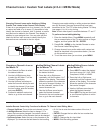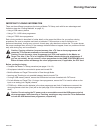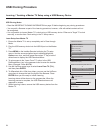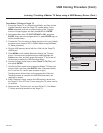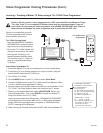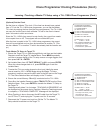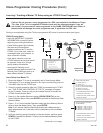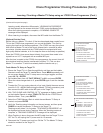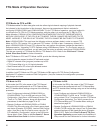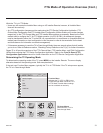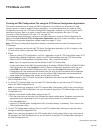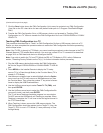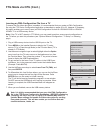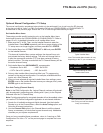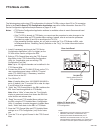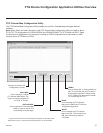
30
206-4186
FTG Mode of Operation Overview
FTG Mode via CPU or EBL
FTG Mode enables Pro:Idiom decryption and also allows logical channel mapping of physical channels.
As indicated in the introduction to this document, there are two separate and distinct methods for
configuring LD320H/LD325H and LD340H/LD345H TVs for FTG Mode of operation: one (new) method is
to configure the TV CPU for FTG Mode operation, while the other is to configure the TV EBL for FTG
Mode operation. FROM A LOCAL CONFIGURATION STANDPOINT, EACH OF THESE METHODS IS
MUTUALLY EXCLUSIVE. IF THE CPU IS IN FTG MODE, THE EBL CANNOT BE SWITCHED TO FTG
MODE. LIKEWISE, IF THE EBL IS IN FTG MODE, THE CPU CANNOT BE SWITCHED TO FTG MODE.
Note: LD320H/LD325H TVs must have the following minimum software loads in order to support FTG
Mode via CPU: CPU version 3.61 or later and PTC version 1.01.008 or later. If necessary, contact LG to
obtain LD320H/LD325H CPU and PTC software files, and perform the software updates as described in
Reference section, “Upgrading TV/PTC Software using a USB Memory Device.” If a Pro:Centric server is
installed in the institution head end, you will also have the option to remotely reconfigure LD320H/LD325H
TVs that are currently in FTG Mode via EBL for FTG Mode via CPU. Refer to the Pro:Centric™ Server
Admin Client User Guide for further information.
Both FTG Mode via CPU and FTG Mode via EBL provide the following features:
• Logical channels mapped to either RF delivered content.
• Digital RF channel minor (program) numbers up to 255.
• FTG Channel Map of up to 141 logical channels.
• Start Channel set for RF or Aux input delivered content.
• Pro:Centric data delivery over RF.
In addition, both FTG Mode via CPU and FTG Mode via EBL require LG FTG Device Conguration
Application PC software to create an FMA Conguration (.fma) le. However, the conguration processes
then diverge as follows:
FTG Mode via CPU
In this mode, the CPU is the owner of the FTG Channel
Map and must be congured with an FTG Channel Map
and FTG Installer Menu settings using one of the following
processes:
• Local: Congure an individual LD320H/LD325H or
LD340H/LD345H TV via its USB port using an FMA
Conguration (.fma) le on a USB memory device. The
“Teach to TV (FMA)” process, along with associated
procedures, is described on pages 32 to 35.
• Remote: Congure all LD320H/LD325H or LD340H/
LD345H TVs at the site using a Pro:Centric server head
end device (Example: PCS150R). Load an FMA Congu-
ration (.fma) le on the Pro:Centric server using the TV
E-Z Installation “Conguration” option in the Pro:Centric
Server Admin Client. Refer to the Pro:Centric™ Server
Admin Client User Guide for further information.
FTG Mode via EBL
In this mode, the EBL is the owner of the FTG Channel
Map and must be congured with an FTG Channel Map
and FTG Installer Menu settings using one of the following
processes:
• Local: Congure an individual LD320H/LD325H or
LD340H/LD345H TV’s EBL via its TV-LINK CFG jack
using a direct PC-to-TV connection and the FTG Device
Conguration Application. The “Write” process for an
FTG Channel Map and FTG Installer Menu settings is
described on page 36.
• Remote: Congure all LD320H/LD325H or LD340H/
LD345H TV EBLs at the site using a Free-To-Guest Man-
agement Appliance (FMA) head end device (Example:
FMA-LG101). Refer to the Free-To-Guest (FTG) Con-
figuration Application manual and/or the Installation &
Setup manual for the FMA device for further information.



